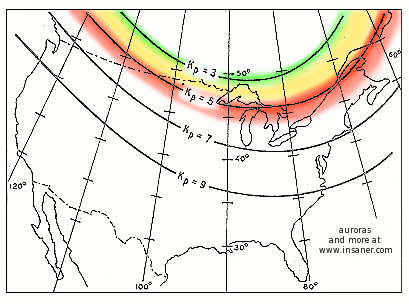Auroras and the Kp index
Estimated 3-hour Planetary K index source
The Northern Auroral Oval source
Explanation
What does the "Kp index" mean? What does it have to do with the phenomenon of auroras (Aurora Borealis occur in the northern hemisphere, and the Aurora Australis occur in the southern hemisphere)? Well, the auroras are caused by excited particles in the atmosphere returning to their normal state and thus releasing protons. The particles in the geomagnetic field of the Earth are excited when they are struck by radiation from the sun during geomagnetic storms. As the field adjusts to this energy, it releases magnetic energy which streams along the geomagnetic field lines. It's this energy that when it ends up in the neutral part of the atmosphere, and is released, causes the auroras.

The Kp-index is basically a calculated average index of the K-indices of several of these observatories. The Kp-latitude map above shows how high the Kp index has to be for auroras to be visible at that latitude. So, along with the Kp index plot (estimated planetary K-index), and a good notion of where on the map you are, you can find whether you can see auroras where you are right now.
source: Relationship between Kp and the Aurora, more k index info
Video explanation
And here's an excellent video by NASA's Solar Dynamics Observatory, which also explains sun spots and other solar-related phenomena.